Babbacombe Cliff Railway, Torbay
TODAY'S ITINERARY
Exploration: Friday, 28 June, 2019
lv London Paddington 0635 Great Western Railway
ar Exeter St Davids 0841
lv Exeter St Davids 0900 Great Western Railway
ar Exeter St Thomas 0903
lv Exeter St Thomas 1008 Great Western Railway
ar Exeter St Davids 1014
lv Exeter St Davids 1016 Great Western Railway
ar Exmouth 1048
lv Exmouth dock 1140 Starcross Exmouth Ferry (boat)
ar Starcross dock 1200
lv Starcross 1209 Great Western Railway
ar Torquay 1251
lv Torquay Grand Hotel, Stagecoach South West (bus)
ar Babbacombe
lv Babbacombe, Stagecoach South West (bus)
ar Paignton bus station
lv Paignton 1619 Great Western Railway
ar Exeter St Davids 1711
lv Exeter St Davids 1715 Great Western Railway
ar London Paddington 2006
If you don't want to spend an hour at Exeter St Thomas, and why would you, you could leave an hour later. I did want to go there, for the separate Atmospheric Road project[note 1], but unless you are into historic but very plain railway stations, you are better off skipping it. For that matter you could also leave Paddington even later for a direct train to Torquay, but then you'd miss the boat ride and I do recommend that.
The Circle Line is not very busy at 05:45. I captured my reflection in the window while we were between stations.

I was going to take the same Great Western train that I used on the Lynton and Lynmouth expedition, and I expressed my thoughts on Paddington railway terminus on that page. My train that day took me to the Bishop's Road Paddington station, but this day the Circle Line train unexpectedly ran through to the Praed Street Paddington station. It's on the extension of the Metropolitan Railway opened in 1868 running to South Kensington, and you should visit this or one of the others that has its glass roof still intact. It's not your ordinary rapid transit station, not even in London. The footbridge brings you to the entrance at Praed Street and the underpass to the railway terminus.
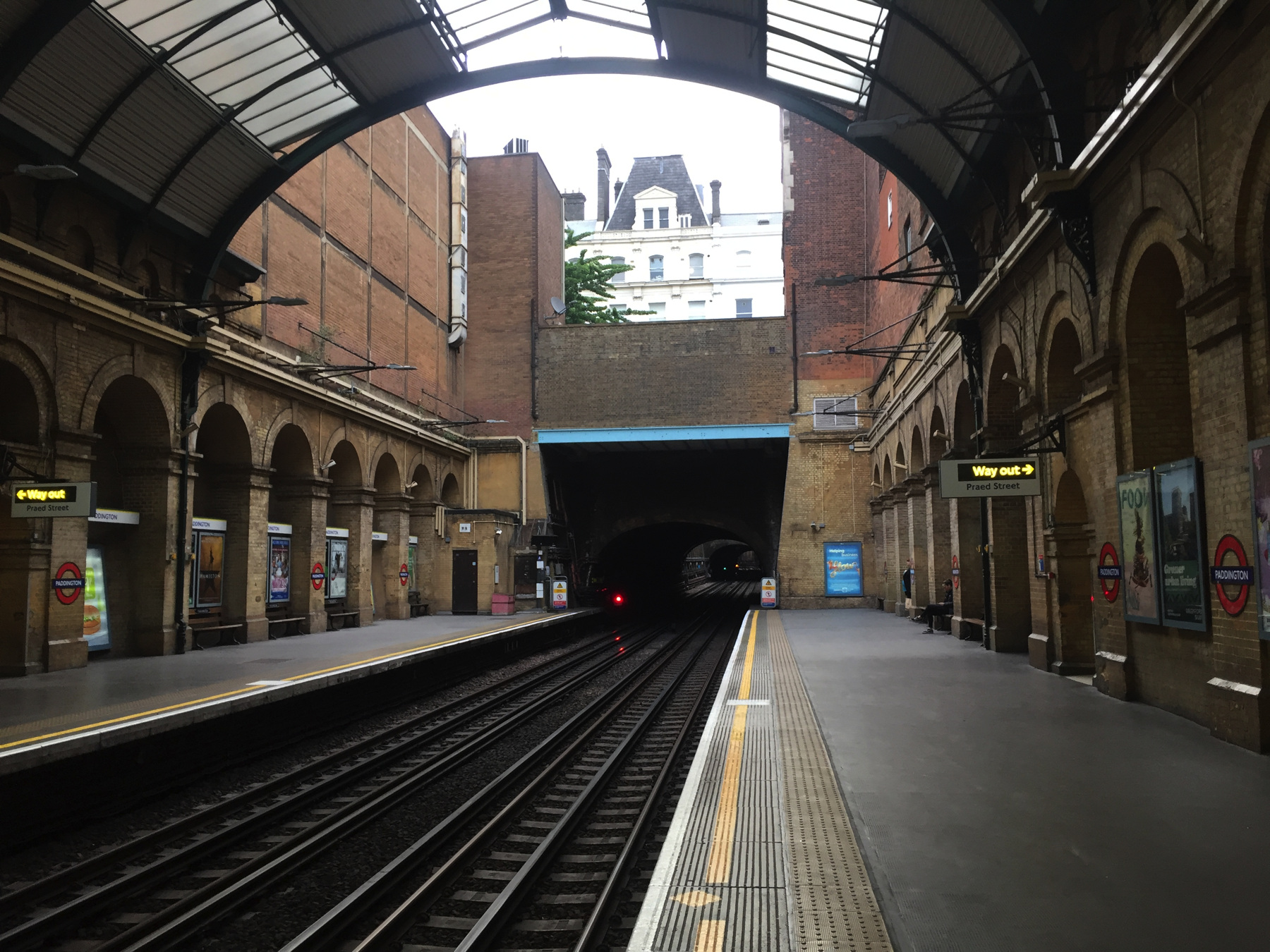
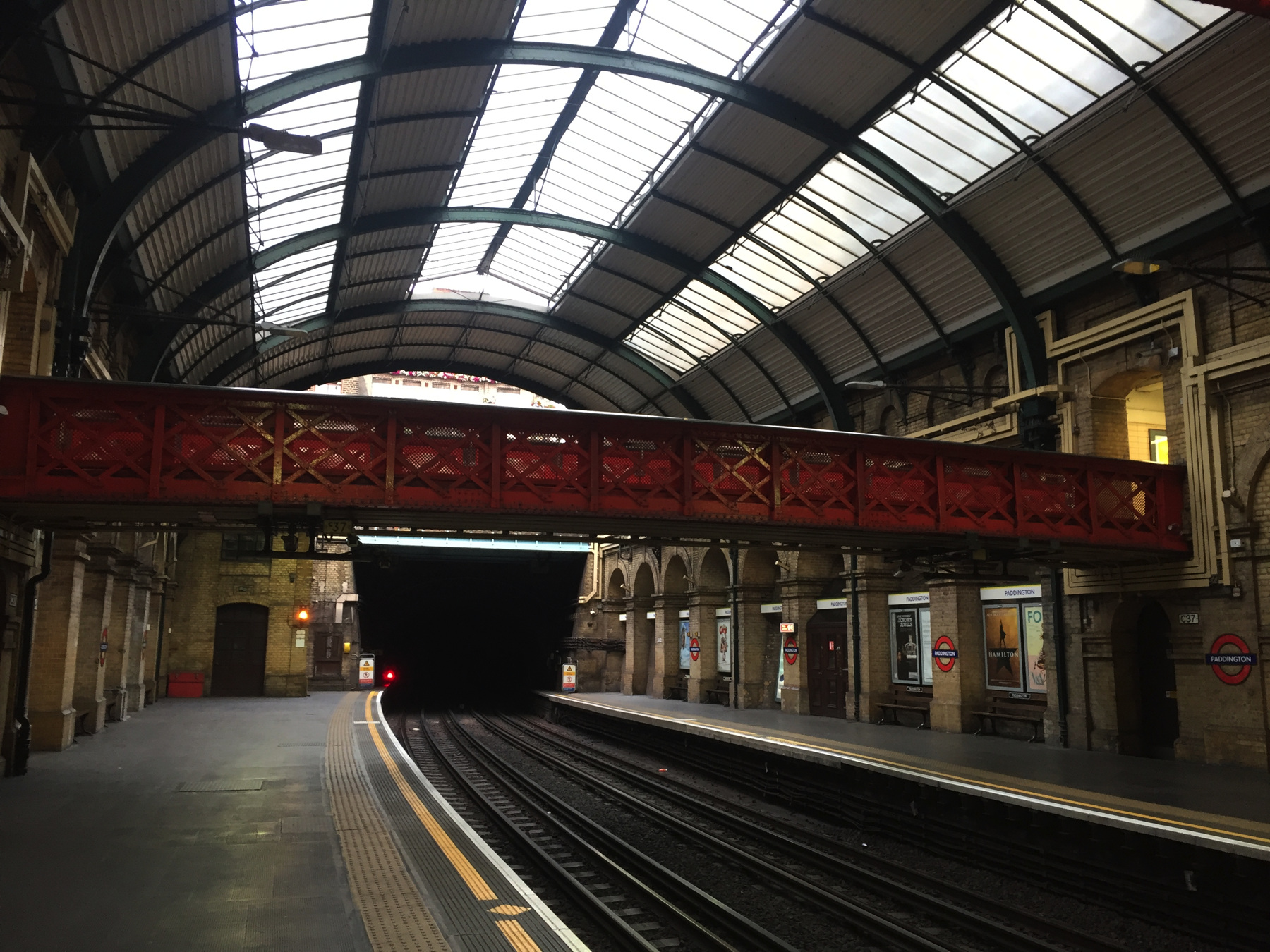
Below, Exeter St Thomas station, the north terminal of the South Devon Railway, an atmospheric railway[note 1] that opened in 1846. Not much, is it? There was originally an iron and glass roof over the track and platform. The yellow building was the station house but is now a nightclub. The current offering for railway travel is two platforms with a bus shelter on each one. Here at nine in the morning people want to go to St Davids or somewhere beyond. Most of the trains that call at St Thomas change ends at St Davids and continue through Exeter Central to Exmouth, and that's what my train did, an hour later than the one those people are expecting.
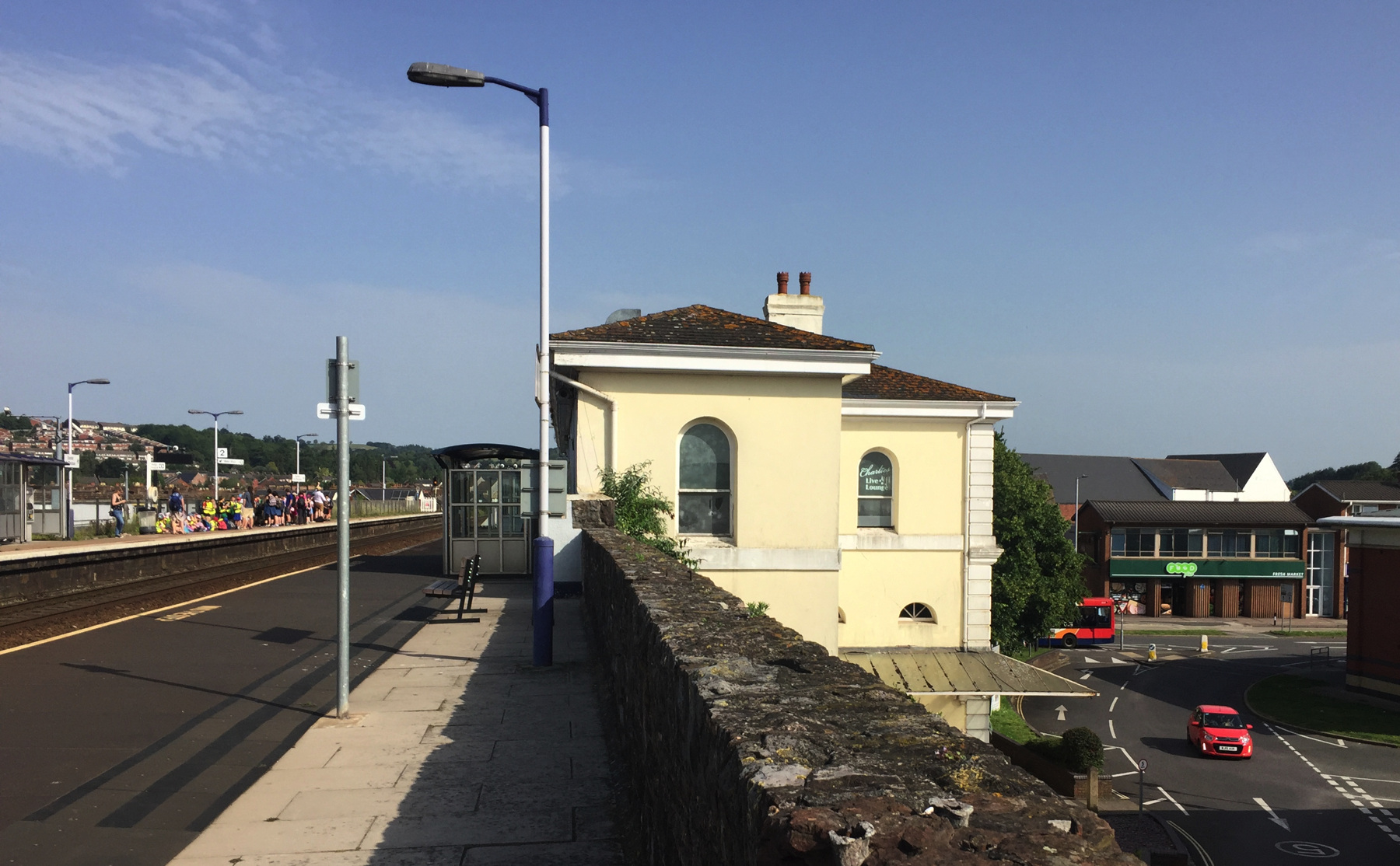
The river is called the Exe because:
(a) No one could think of a name for it, so they called it X, and it
stuck.
(b) It was the tenth river at which the Romans settled in Britain.
(c) It is derived from an ancient Celtic word for water, even though
calling a river Water is as lame as calling it Avon (an ancient Celtic
word for river.)
Apparently (c) is correct. And it struck me only now that the River Esk at Whitby is the same silly name with k and s transposed like they are when people ax a question. (The same ancient word for water is the basis of the word whisky from Irish and Scottish Gaelic.)
The name Exeter is a contraction of Exe chester, for the Roman fort (castrum) established in the year 40. Some of the Roman wall, repaired over the centuries, still stands. Exeter is the head of navigation (improved by a canal), and it has been the major city of southwest England for centuries. Its cathedral is exceptionally fine. The northern half of a thirteenth century bridge can be seen in a park not far from the modern course of the Exe. The chapel at the bridge's now-gone southern end was dedicated to St Thomas, for which the neighborhood and later the station was named.
The name Exmouth needs no explanation. Near its mouth the river is very wide and not very deep, before it narrows to pass between Exmouth and the sand spit of Dawlish Warren, after which it joins the English Channel.
You get a good view of the river from the train on the right bank, but you get an even better view if you ride down the Avocet Line to Exmouth and take the ferry across to Starcross. The boats run from April to October, sometimes not in bad weather or at especially low tide, so you can either contact the company on the day or just take your chances. I think I mentioned that I live for danger, so I did the latter. On the train I spoke with a man who told me he was on his way to a job in IT at an office in Exmouth. He was wearing a T shirt, shorts, and sandals. Why is my office not like his?
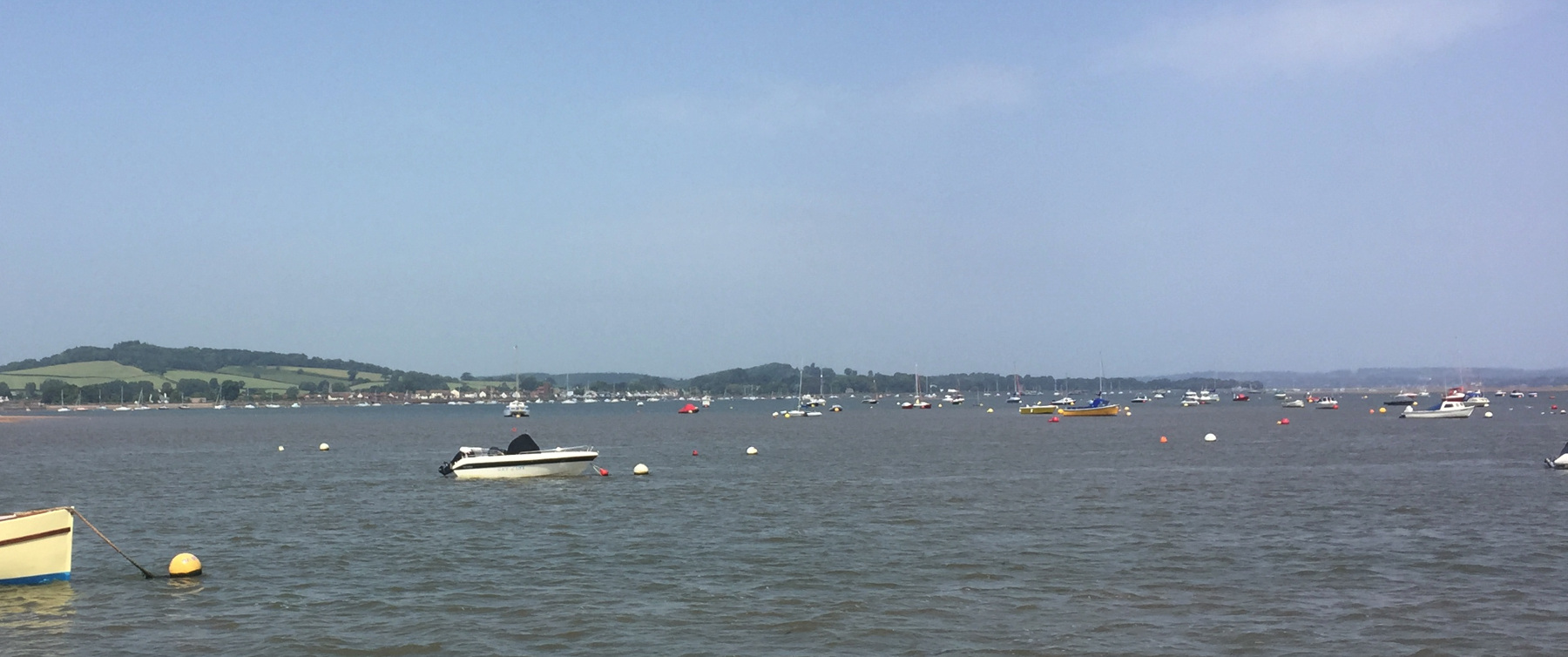
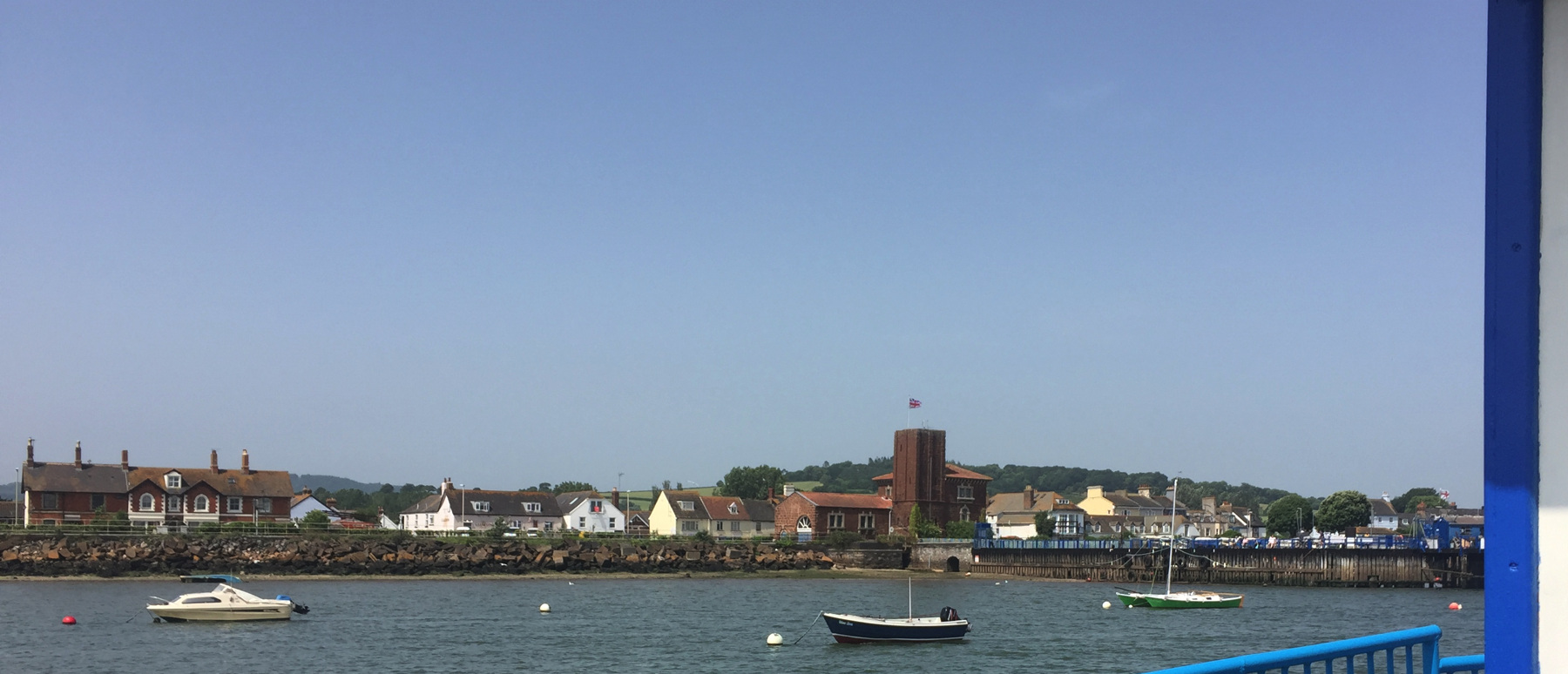
The skyscraper at Starcross, at one time even taller, was a pump house for the atmospheric railway. The boat will bring you to the end of that pier, which is at the south end of Starcross railway station. The station footbridge serves also as the access from the ferry into the town.
You won't wait long for the train to Torquay.
Torquay is an old seaside resort town made popular in the 1840s, the same decade as Llandudno. It's been brought up to date with a dazzling array of modern hotels and amusements. I like the Victorian follies at the entrance to the park near the station.

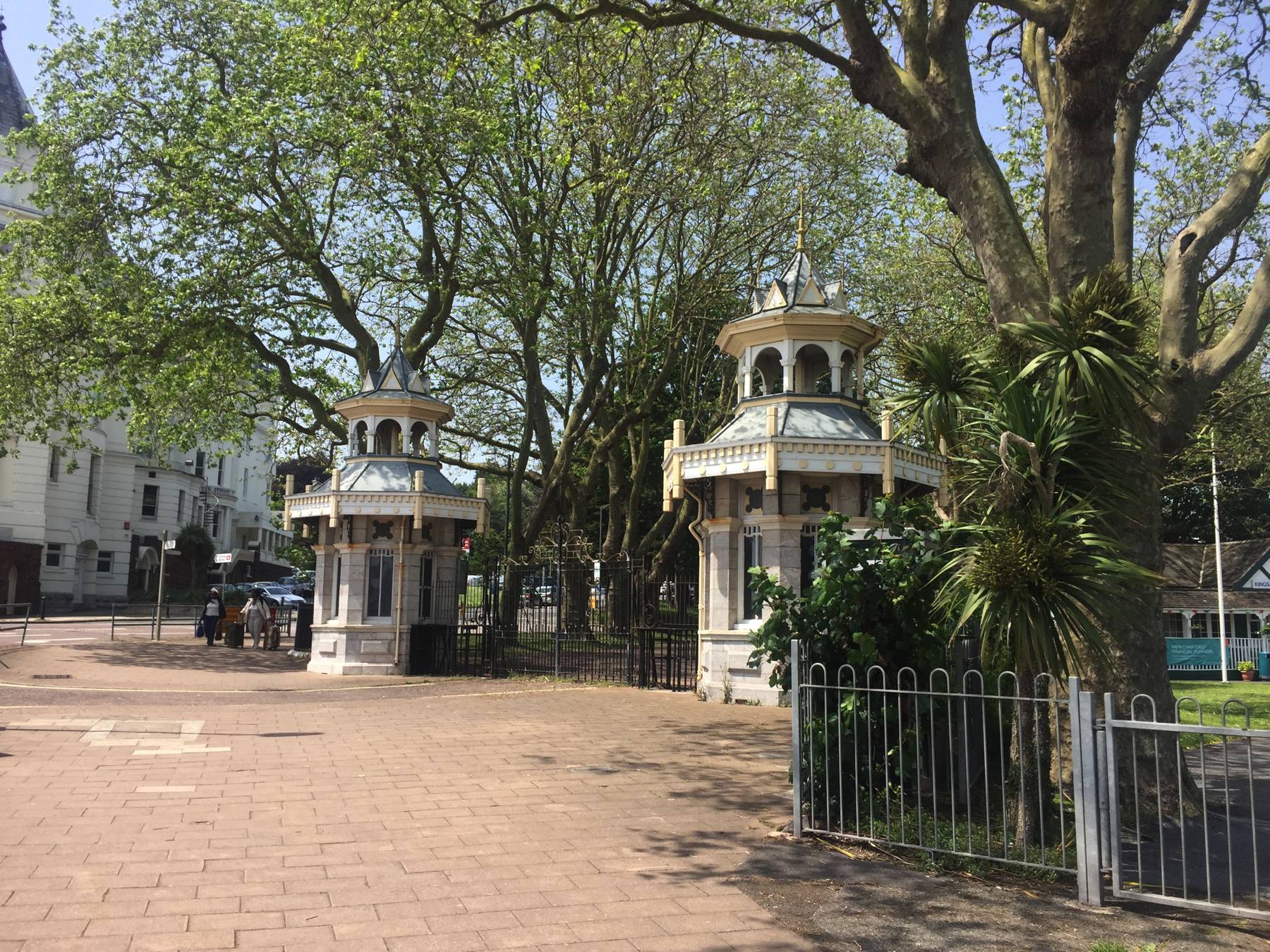
And now finally, a bus ride brings us to Babbacombe, a neighborhood of Torquay, itself a part of the greater Torbay. The element "combe", like the Welsh cwm, refers to a valley without a river in it, so here it refers to the land formations just above the cliff. Babba is thought to be a personal name in Old English or Norse.
Our first picture looks from Babbacombe Downs to Oddicombe Beach, the destination of the cliff railway. The sandstone gradually collapsing into the sea gives a red color to the water, and there were strong waves on this date.
Not far from this scene we find the upper station of the cliff railway. I find it a little comical that so many of the funiculars have an upper station just below street level, requiring passengers to start the journey on foot, as if it would cost too much to go the extra ten feet. Maybe it would.

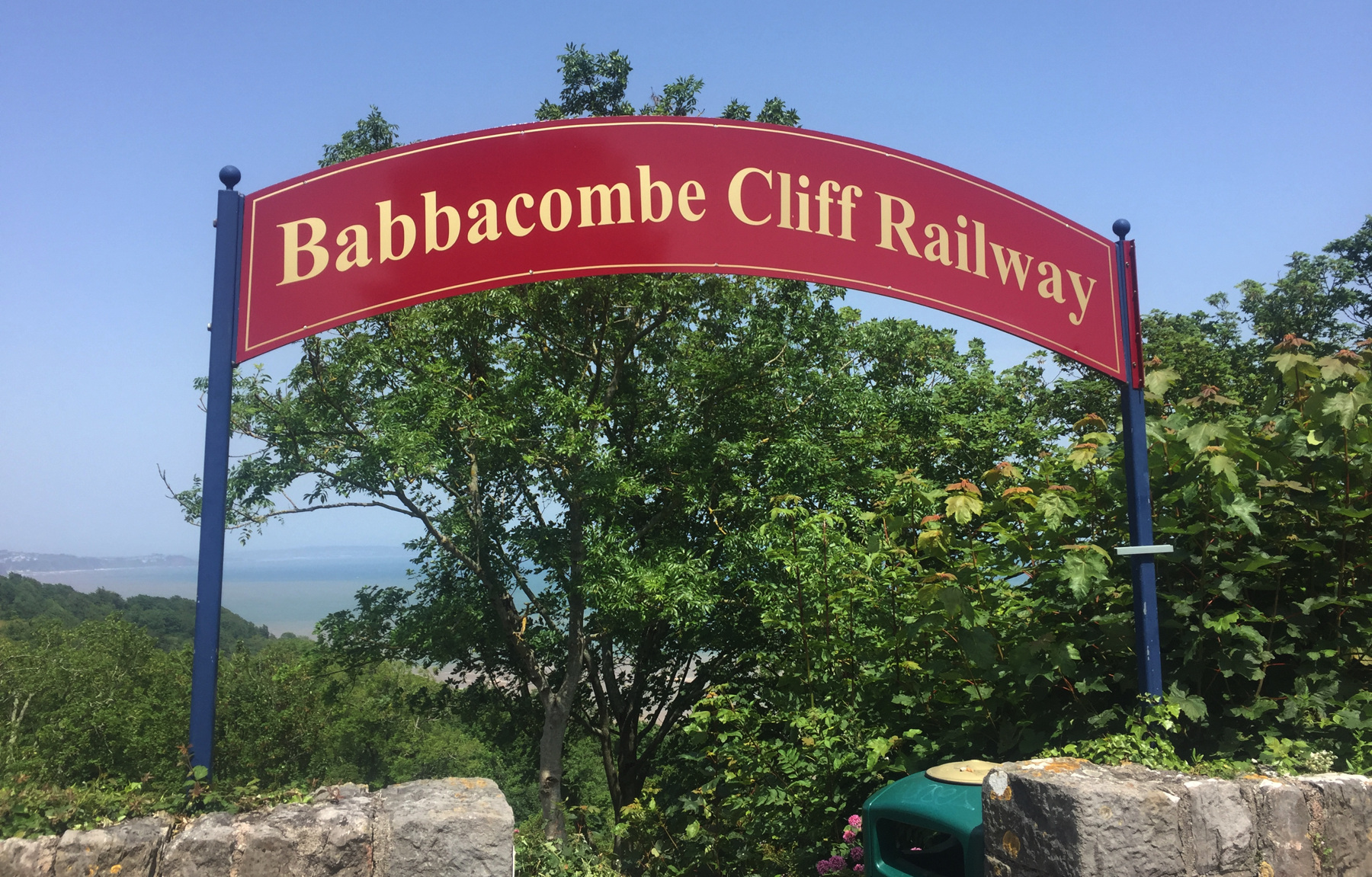
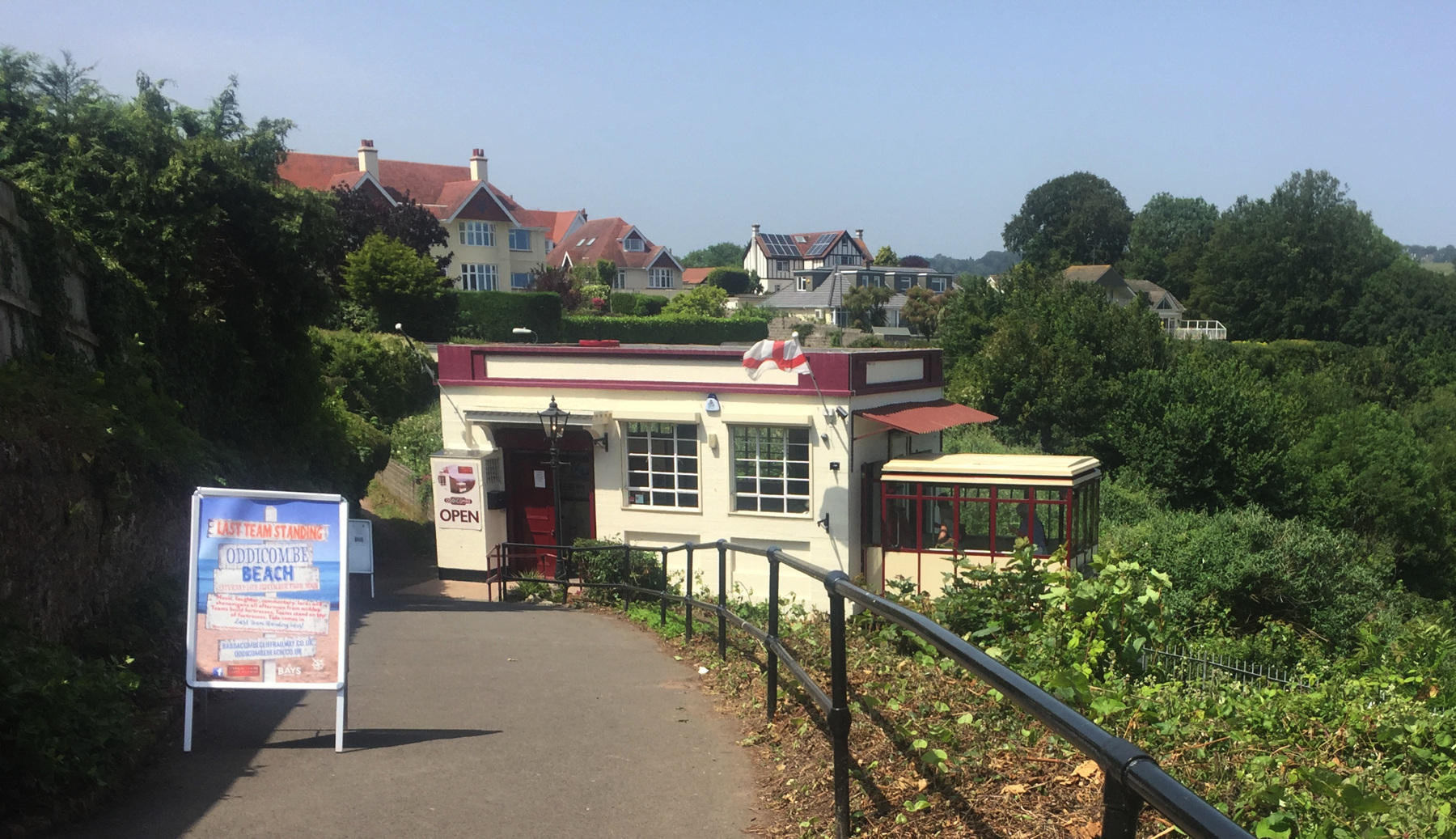
Let's go down to Oddicombe Beach. I wondered whether the name is a joke, but it far pre-dates the funicular. I see Oddicombe Sands on the Ordnance Survey "Exeter" map of 1848. I think Odd is a personal name of Norse origin.
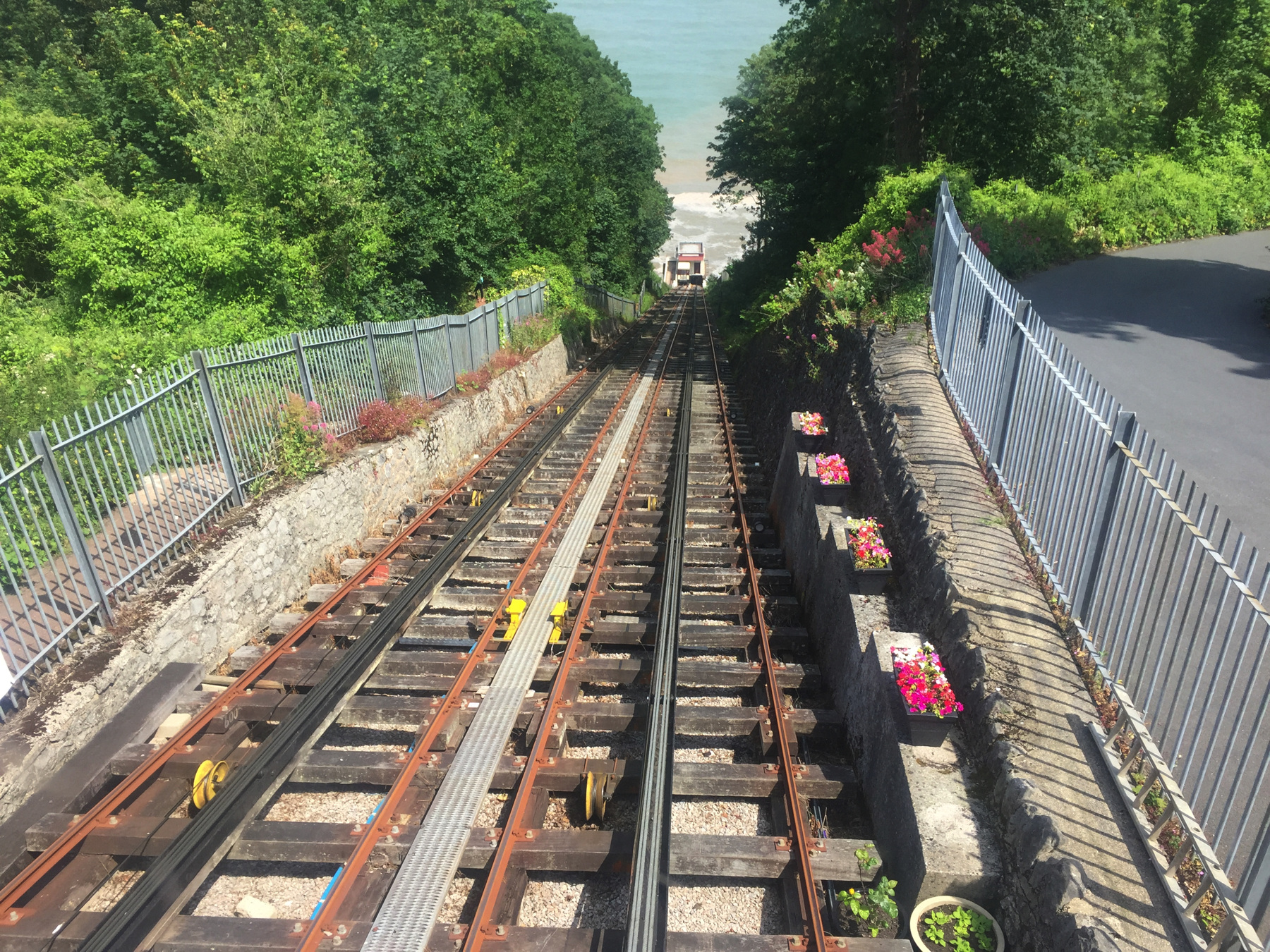
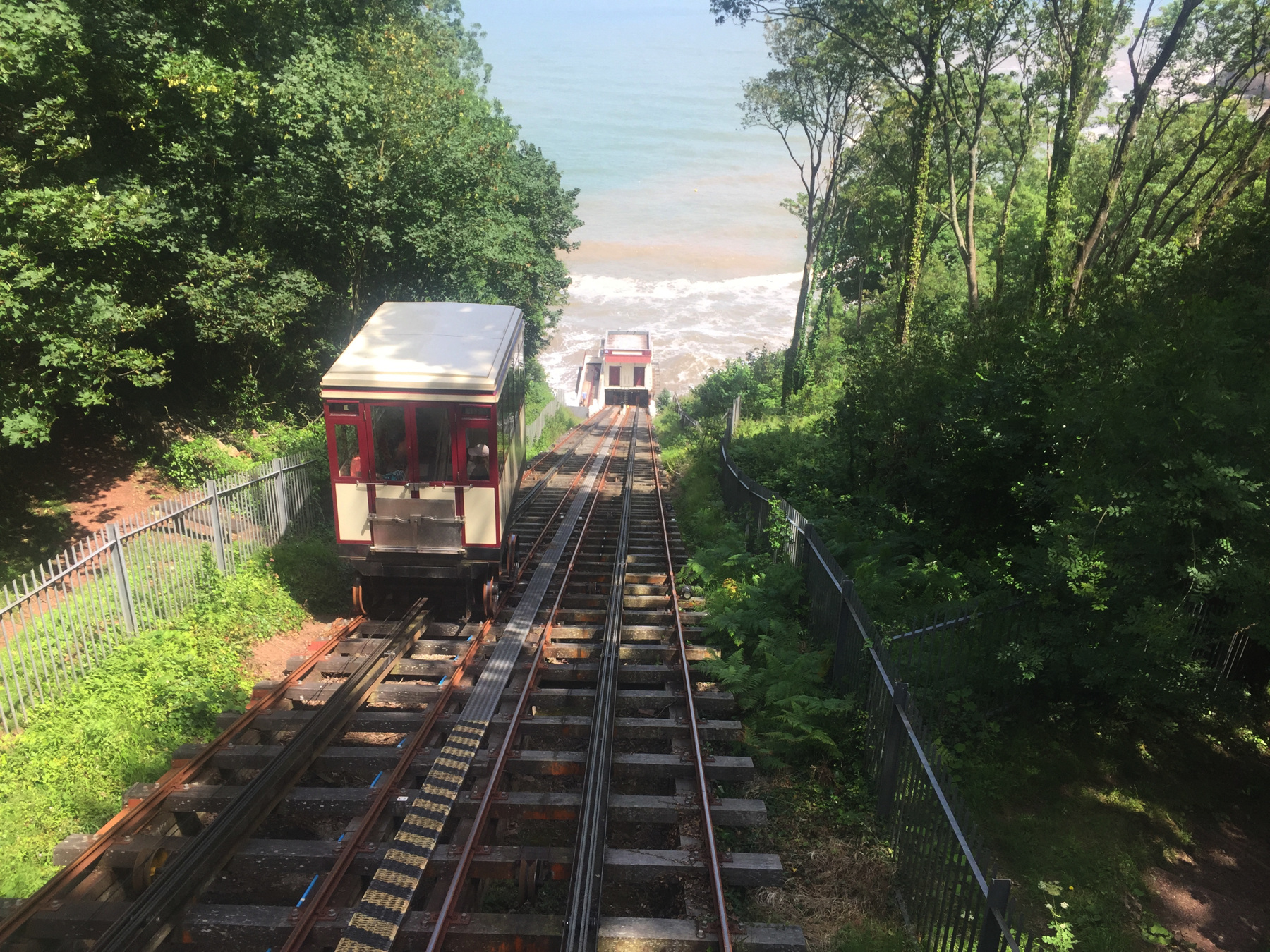
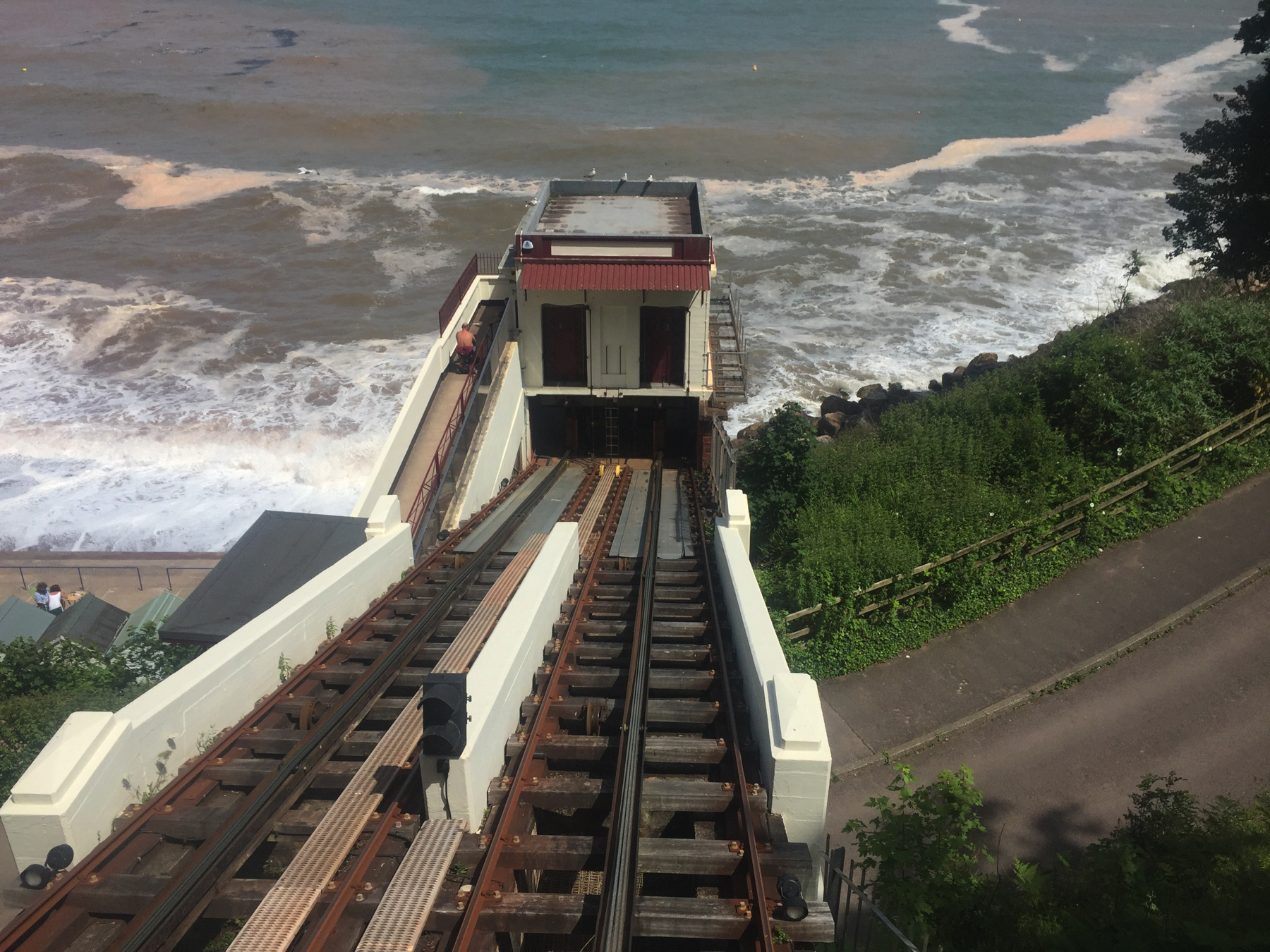
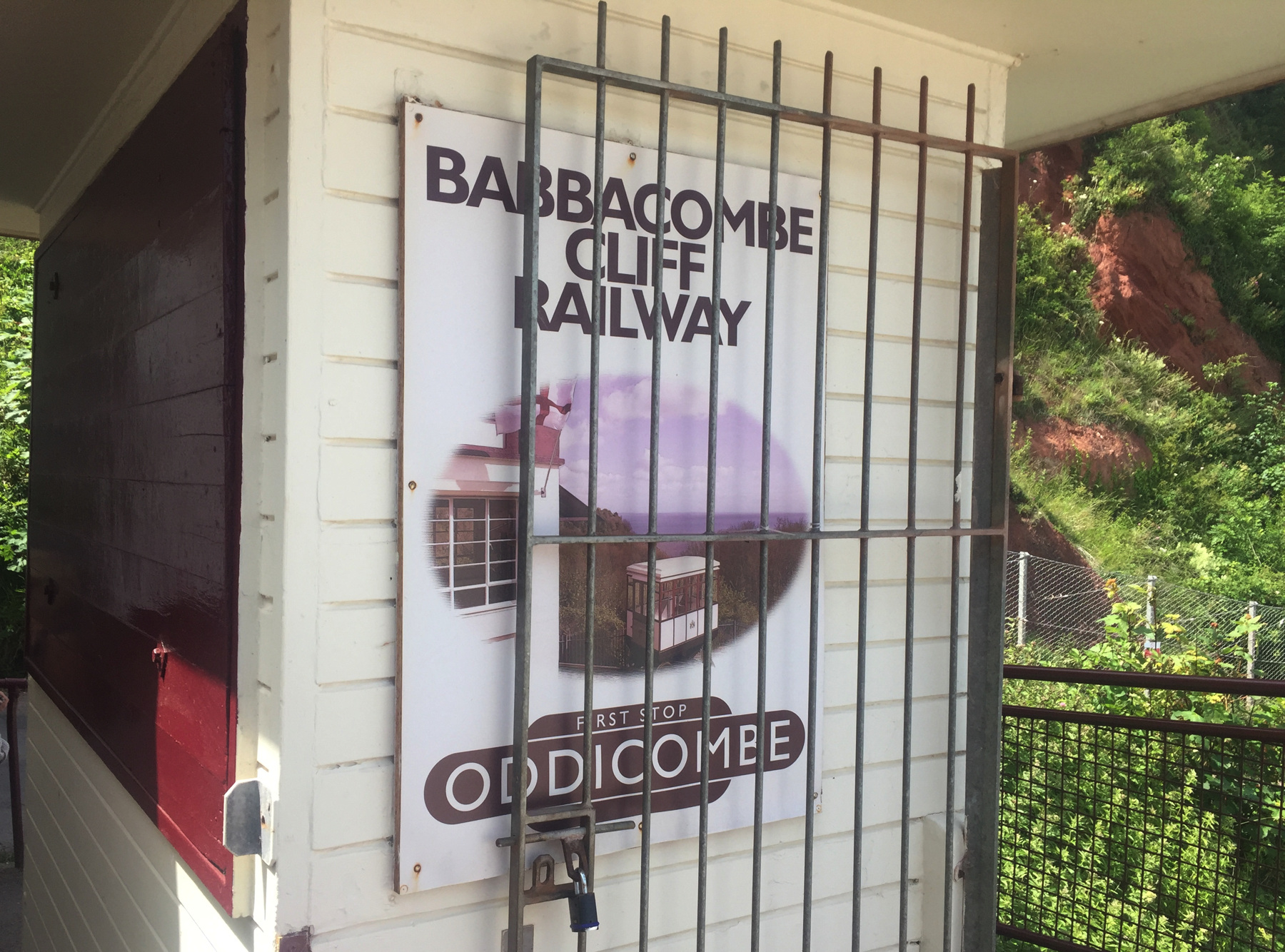
First stop Oddicombe? It better be the only stop.
Nobody was going into the rough water. It was splashing up to the bottom step. You can find other pictures of Oddicombe Beach with great crowds. I took off my shoes and let the cold water wet my feet, but I followed the lead of everyone else and did not venture out.
A side view from the beach shows that the lower station is safely above the water.
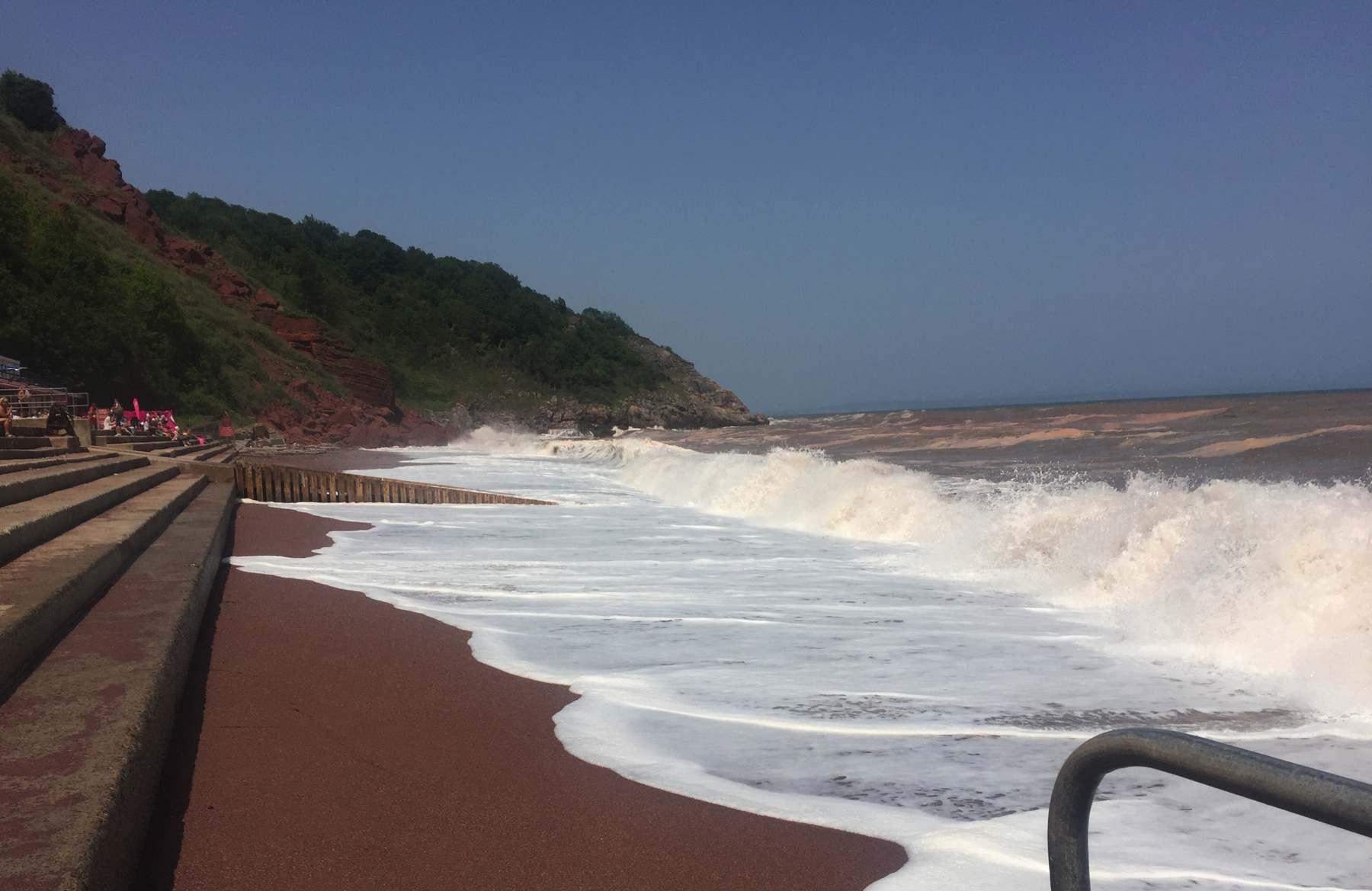
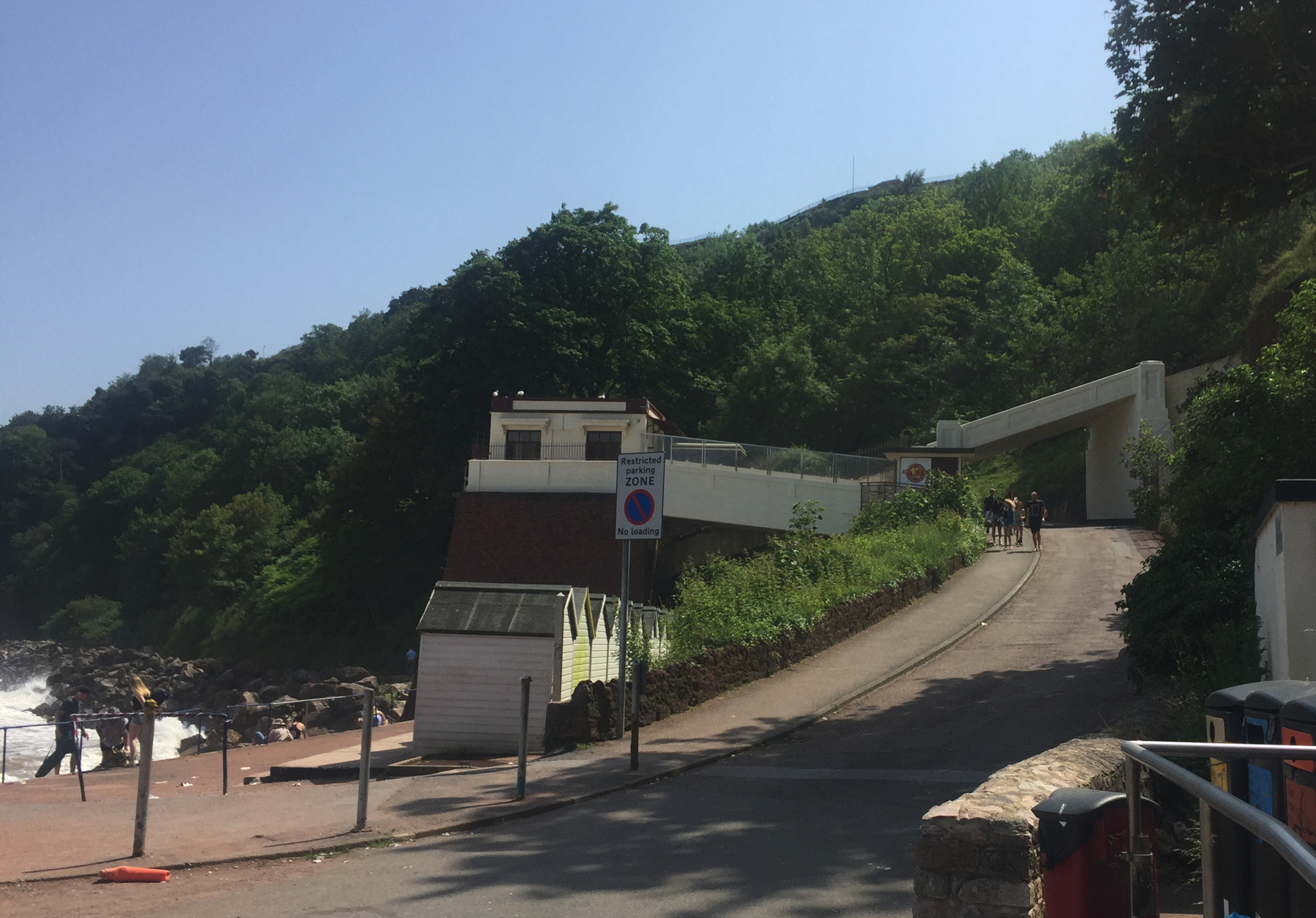
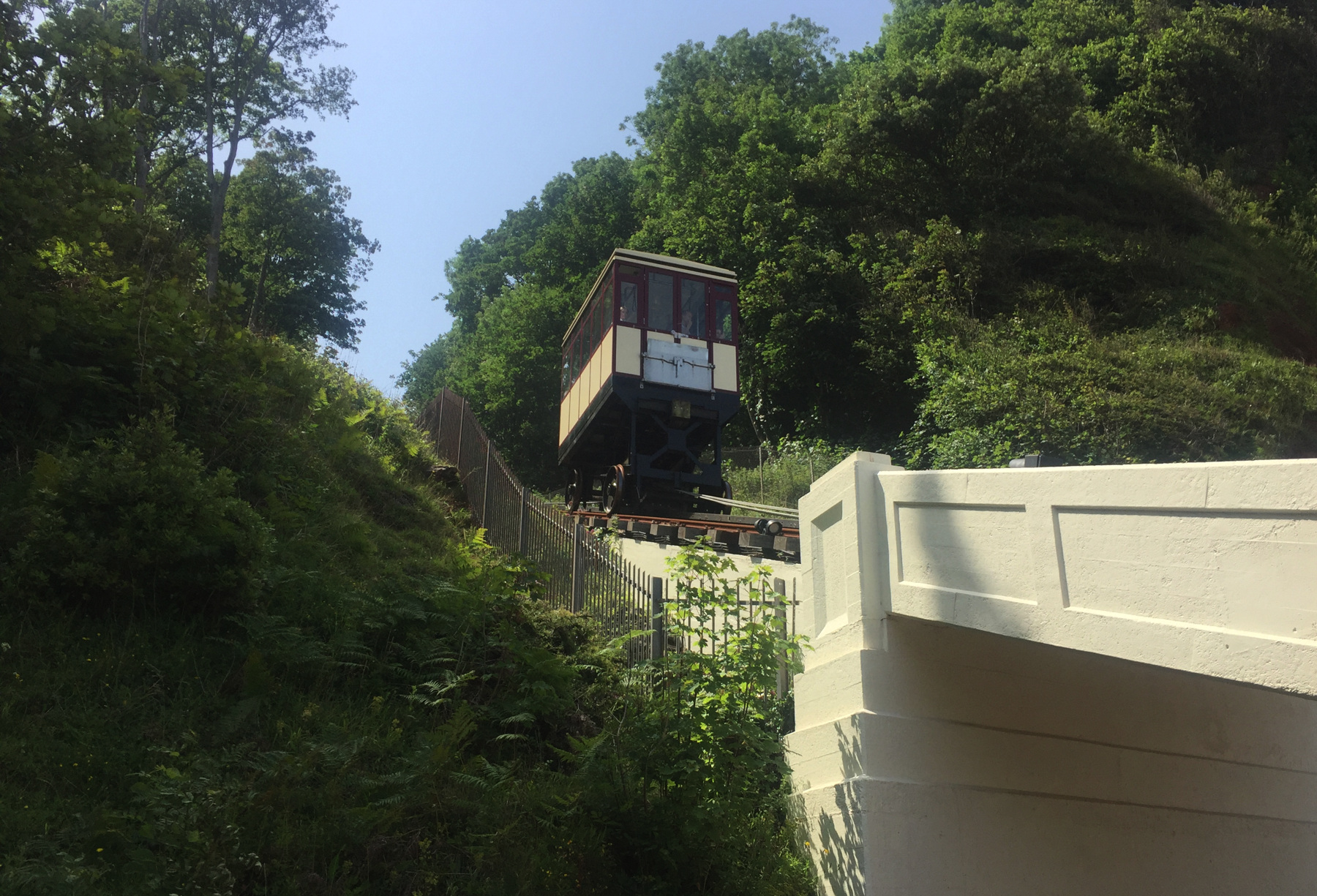
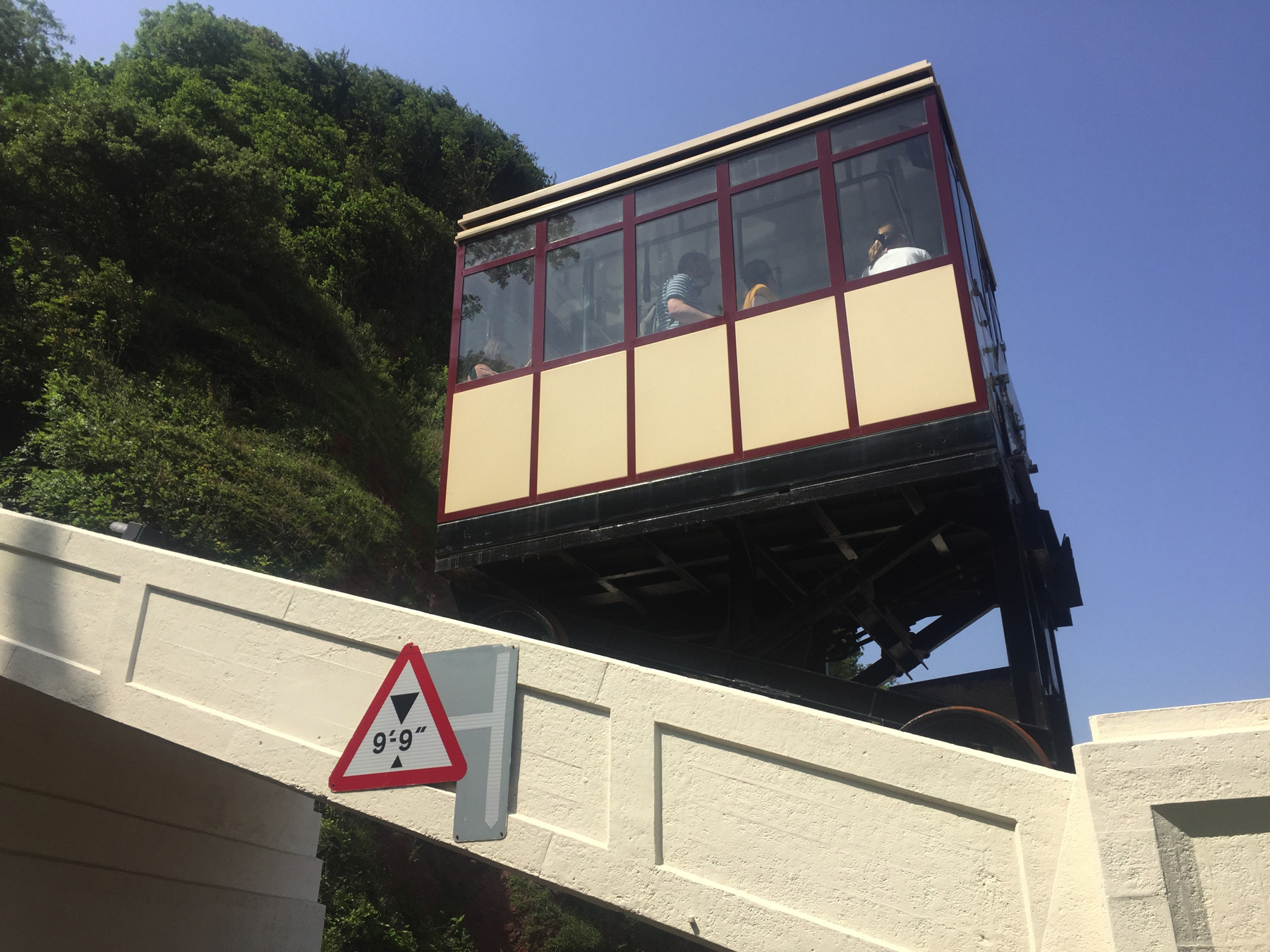
Let's go back up.
I took some detailed pictures of the track and cable. There is a center channel with four ropes but they are two different sets. The four ropes connecting the upper ends of each car run around two sheaves in the engine room. The other four connect the lower ends of the cars, running around sheaves at the lower station, to balance out the rope weight, so that the only difference is the passengers in each car. The water-balanced Lynton and Lynmouth has a lower rope for the same purpose but not all funiculars do. A fifth rope supported by pulleys along the line connects only the upper ends of the cars.
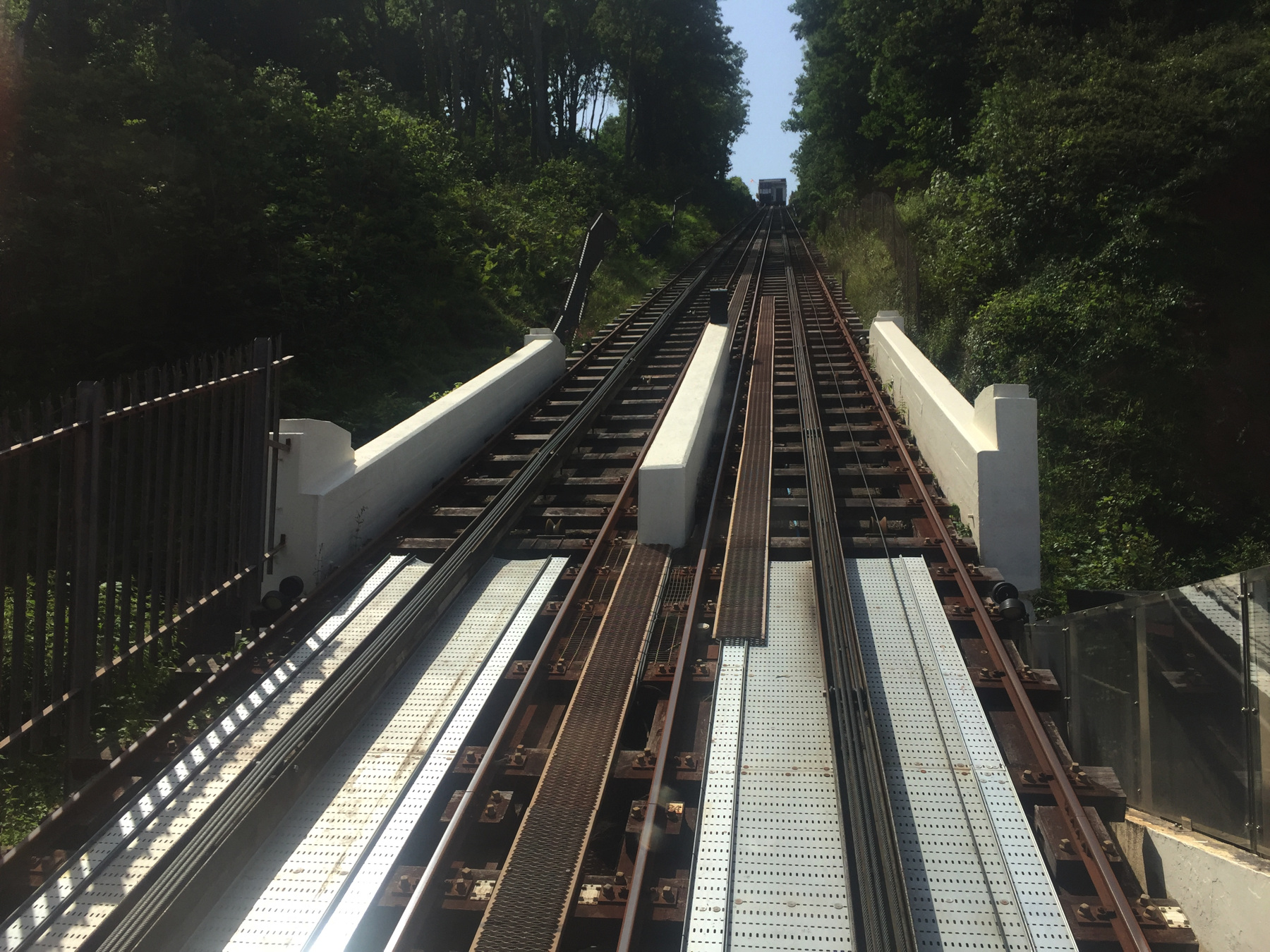
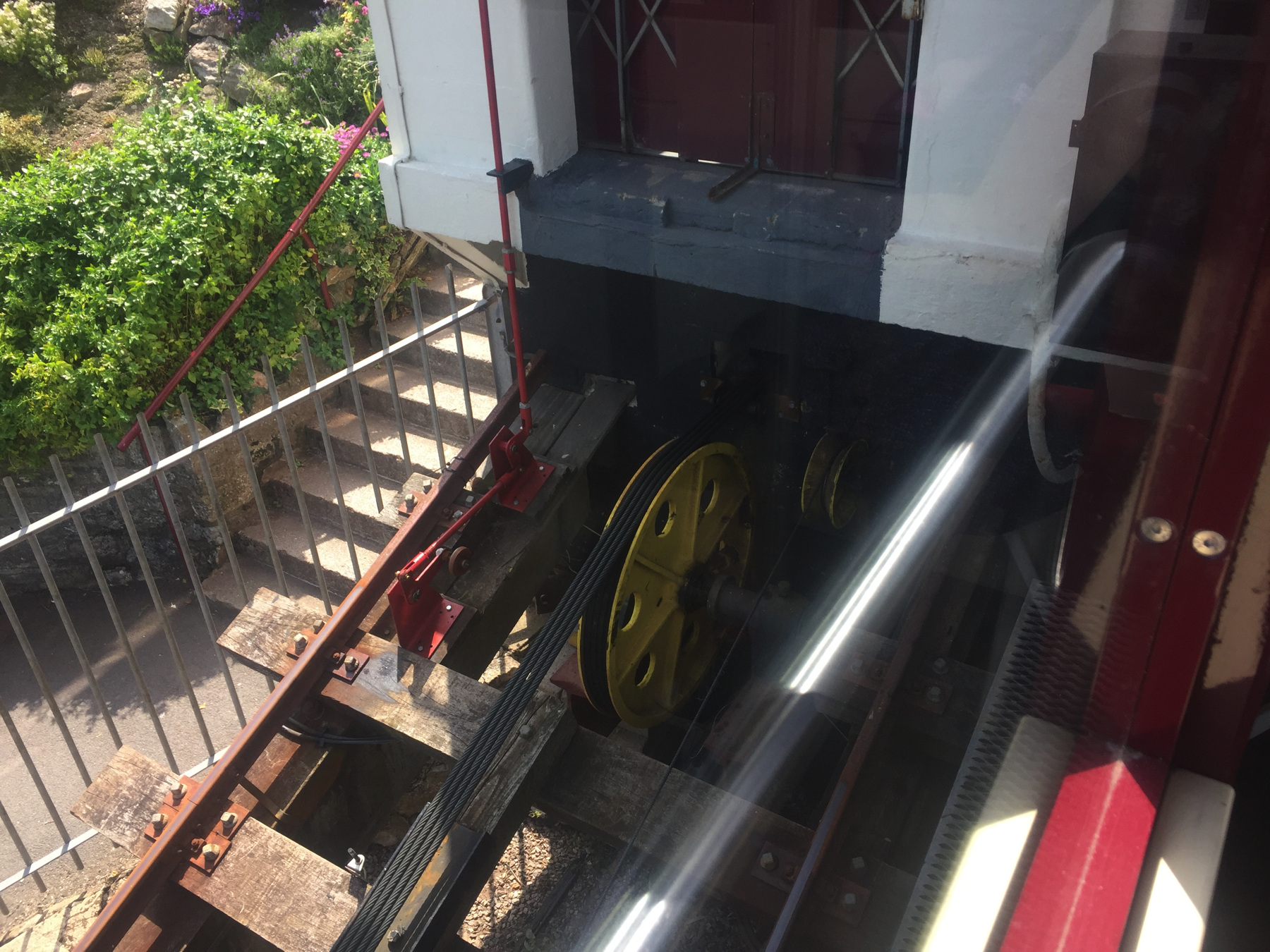
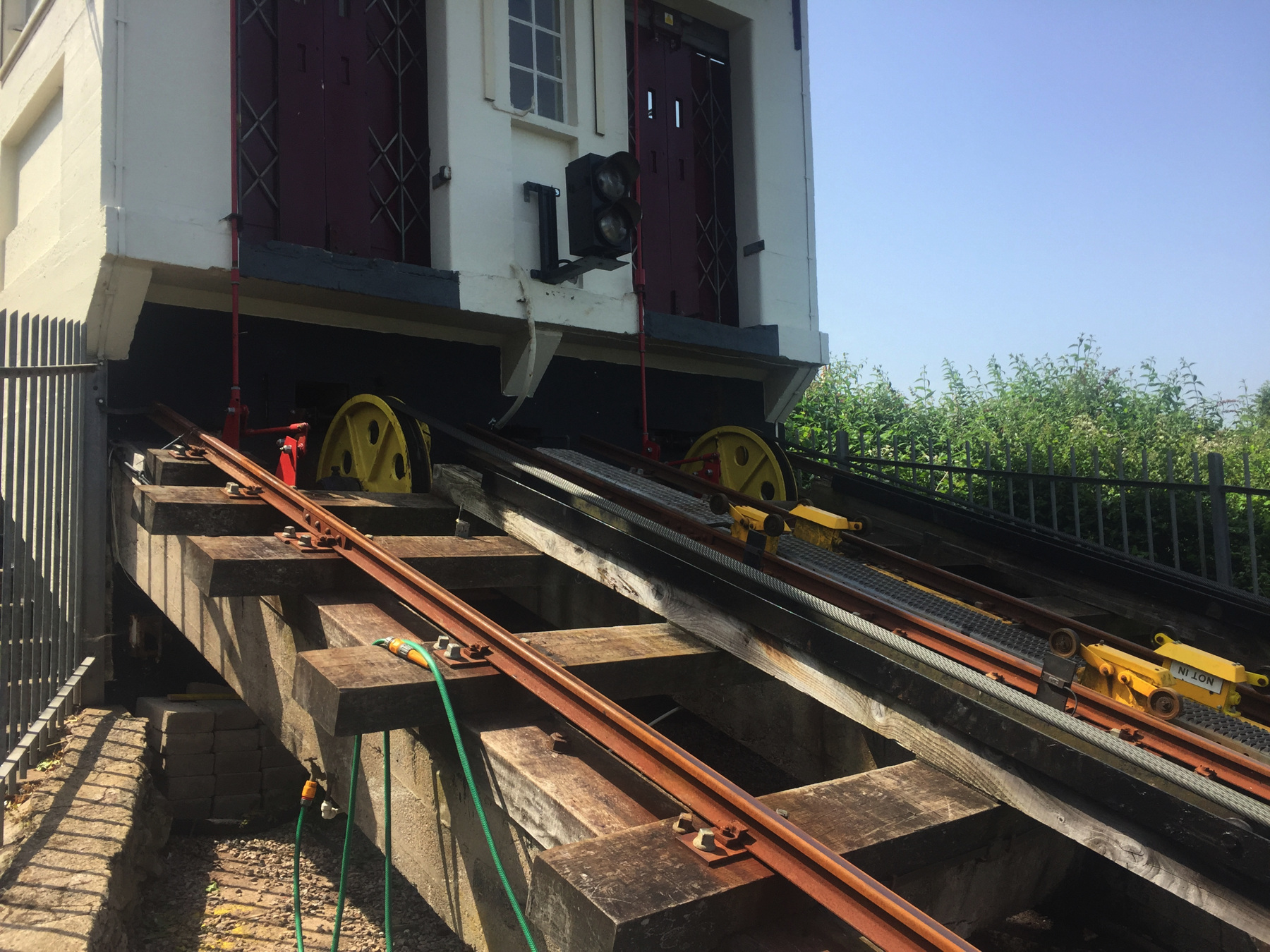
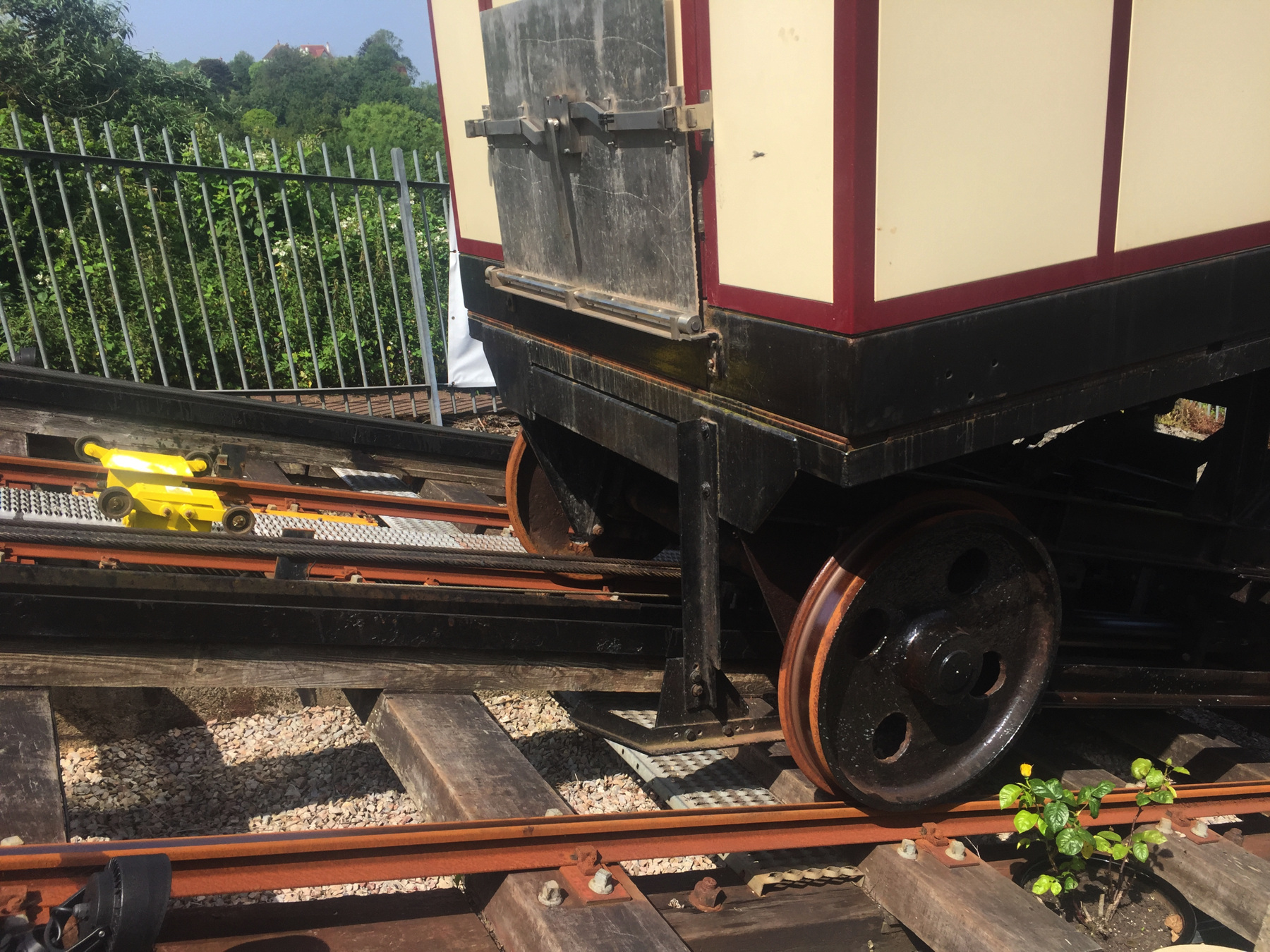
When I had boarded the bus at Torquay the driver told me that an all-day ticket was slightly cheaper than a return ticket to Babbacombe. Since I took the all-day ticket, I decided, going back, to stay on the bus to Paignton and go back on the train from there. It's a good double-deck bus ride. Most of it was in sight of the sea. The bus and rail stations at Paignton are close together.
I just missed a train going out, so I had a little time to spend at the station. Please notice a couple of things in the first picture. First: The train I missed was a Pacer, the 143 class that succeeded the type I rode to Saltburn, but still with bus doors and the rest of the disadvantages. Second: Please notice the steam locomotive. National Rail trains terminate at Paignton, and the rest of the original branch to Kingswear is used by the Dartmouth Steam Railway, operating from a platform on the other side of the fence.
The second picture shows benches with monograms of duelling railways, South Western and Great Western.
The last picture shows that just outside the station is a level crossing with a busy street, an unusual thing in Britain. There is also a footbridge to use in case you can't wait for a train to move along.
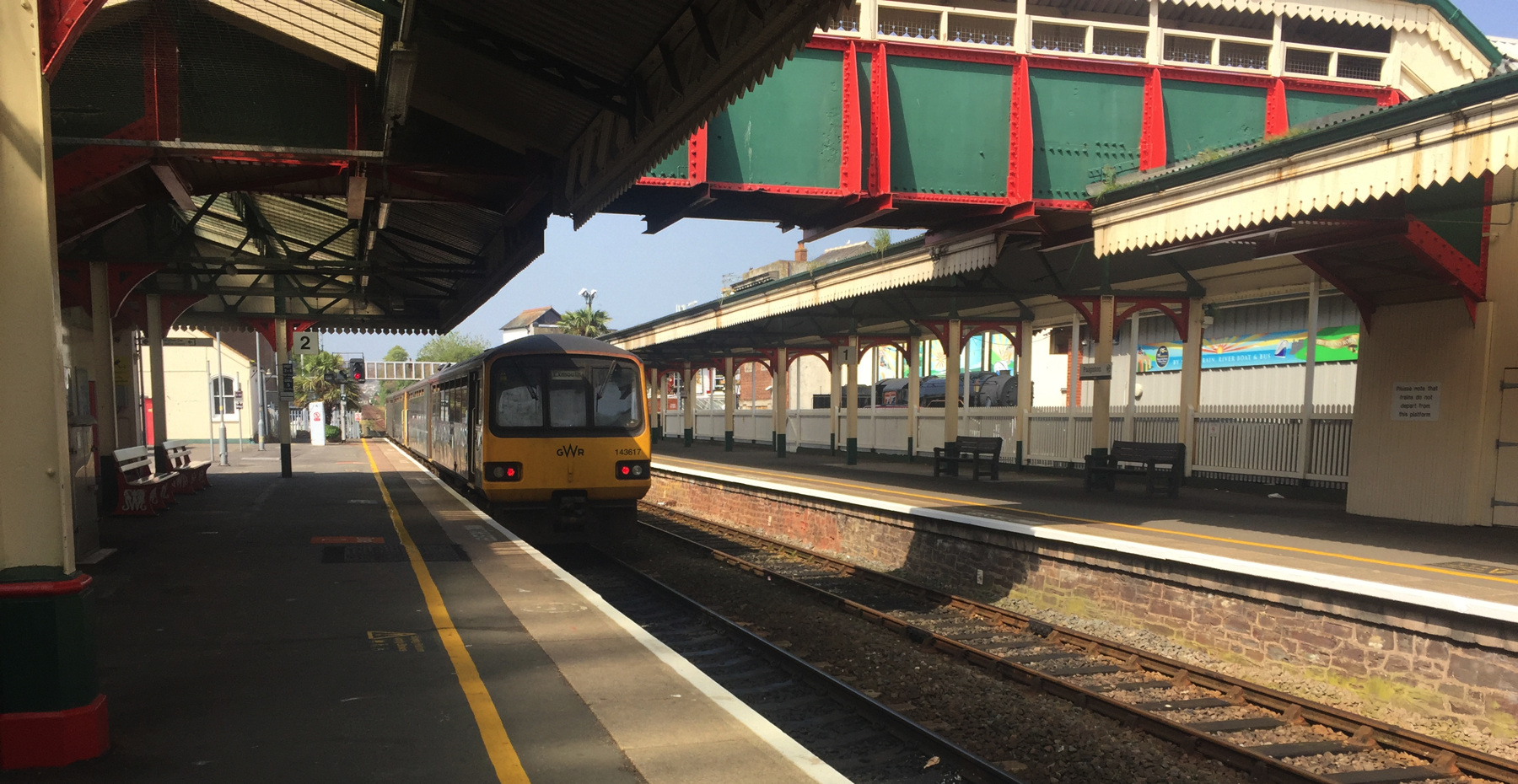

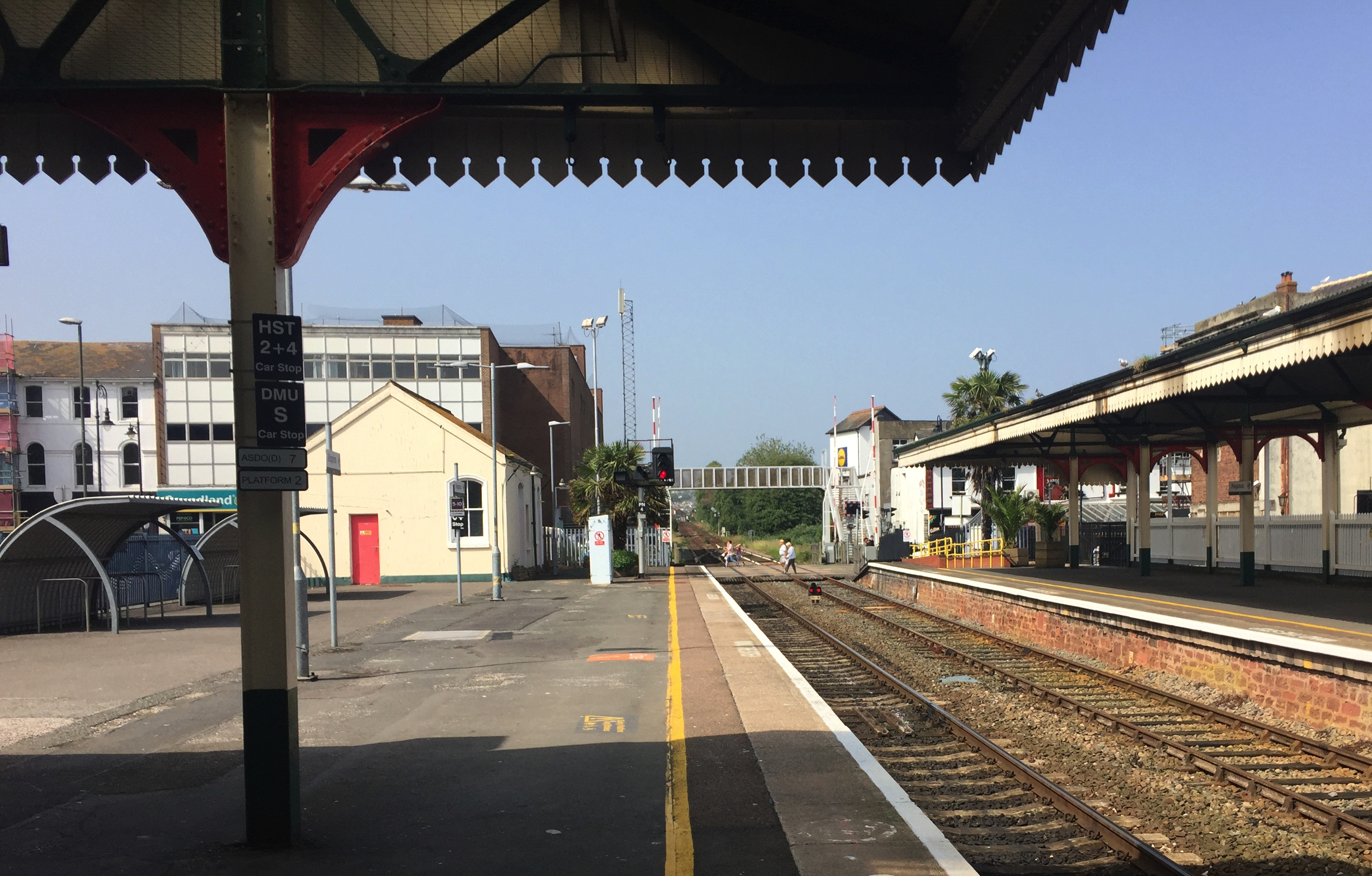
So. That was a full day's worth of fun. I almost didn't mention that a few blocks from the cliff railway is Babbacombe Model Village. If you're more into miniature towns than boat rides, you can get to Torquay almost two hours sooner and you can go see that. I am a big fan of Bekonscot Model Village but I had to make a choice here.
[note 1] The atmospheric railway should not be confused with the atmosphere tramway based on the inventions of the Montgolfier brothers in France. Following their successful manned flight in 1783, they sought ways to exploit it "pour le bien de l'humanité" or at least for their own good. They thought transportation by hot air balloon would be superior to canal boat because the near-absence of friction would make it possible for the mules to walk faster or for fewer mules to be used. Early experiments demonstrated the need for the mules to be heavier than the lift of the balloon. To overcome this, but still minimize friction, the brothers proposed that the mules pull a car on a tramway, with the ropes attached to the car, which would be loaded with sufficient weight to overcome the lift. A tramway would still, they said, be cheaper to build and maintain than a canal, and the mules could go up and down reasonable grades without anything like locks or inclined planes, the mules being limited only by the the weight of the tram car. The first tram de l'ambiance was constructed north from the wall of Paris as far as Allonne as the first part of a route that was intended to reach the port of Calais. Following two weeks of promising operation, on the windy afternoon of June 18, 1792, the balloon lifted the tram car and mules until the ropes snapped. The mules and driver fell a short enough distance to escape fatal injuries, as the balloon drifted off until coming to earth on a hillside near Allonne. Upon landing the frightened attendant immediately ran away without extinguishing the fire, and the fabric of the balloon soon came ablaze. The cargo of bottled Champagne soon began to explode from the heat, sending shards of glass across the field and watering the earth with the precious liquid. Seeing that, the anxious crowd who had gathered at a safe distance cried ah! l'humanité! When the news reached London investors already discouraged by the Montgolfiers' high quotes for use of their patents wrote off atmosphere tramways as a useless and even dangerous idea. A few decades later the Samuda brothers emphasized "atmospherIC railways" whenever their plans were mentioned.